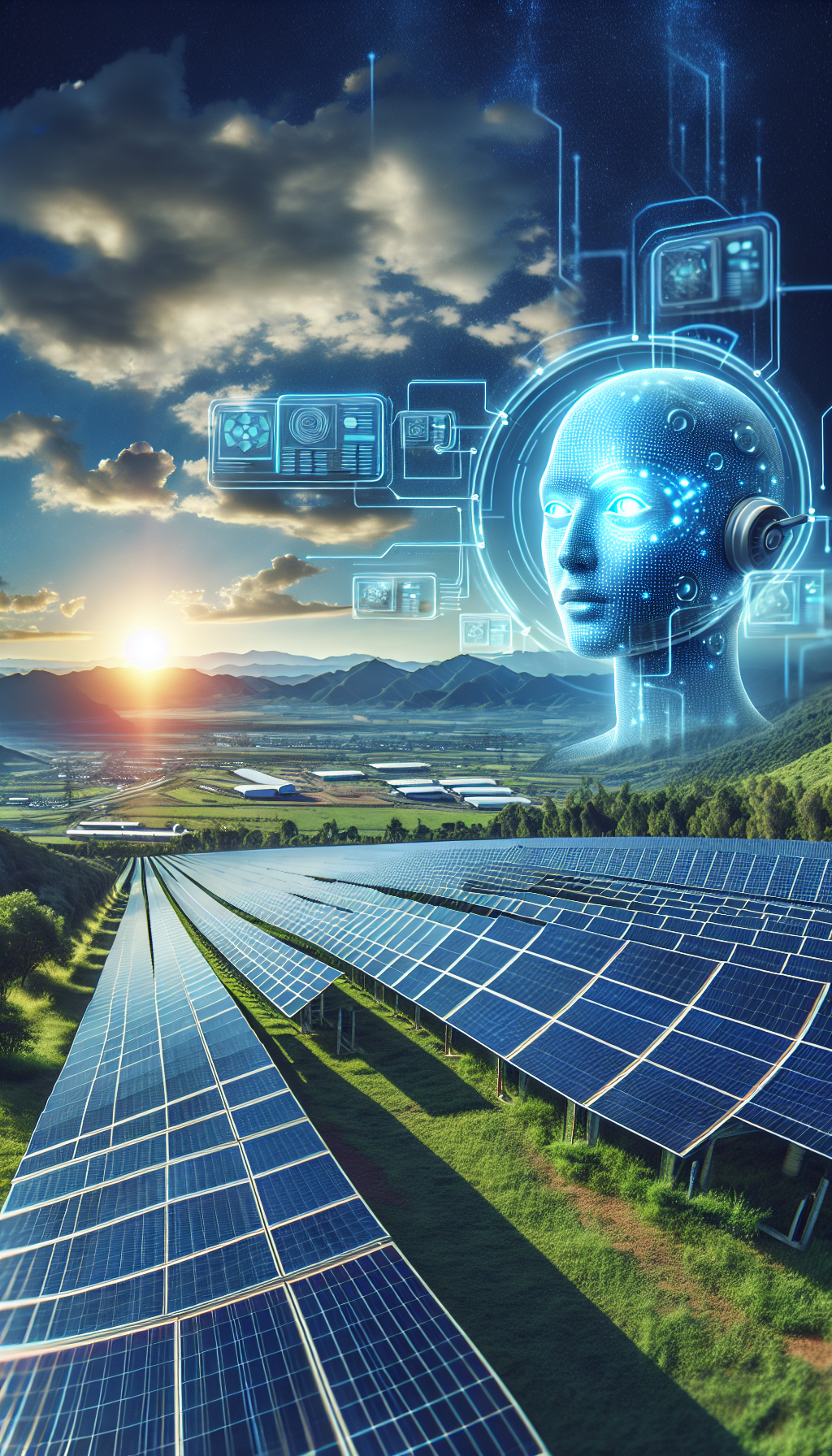The Role of AI in Environmental Monitoring
Artificial Intelligence is playing a crucial role in enhancing environmental monitoring, enabling more accurate and efficient data collection and analysis. AI technologies, such as machine learning algorithms and neural networks, are being utilized to process vast amounts of environmental data, providing valuable insights into ecological patterns and trends. This capability allows for real-time monitoring and rapid response to environmental changes, which is essential for protecting natural resources and biodiversity.
One of the significant applications of AI in environmental monitoring is in the detection and analysis of climate patterns. AI systems can analyze satellite imagery and sensor data to identify changes in temperature, precipitation, and other climatic factors. This information can be used to predict extreme weather events, such as hurricanes and floods, and to develop strategies for mitigating their impacts. Below is a table showcasing the effectiveness of AI in predicting various environmental phenomena:
| Environmental Phenomenon | AI Prediction Accuracy (%) |
|---|---|
| Hurricanes | 85% |
| Floods | 78% |
| Wildfires | 82% |
Furthermore, AI is also instrumental in monitoring air and water quality. Advanced AI models can analyze data from sensors placed in urban and rural areas to detect pollution levels, identify sources of contamination, and suggest remediation strategies. This not only helps in maintaining public health but also aids in enforcing environmental regulations. The integration of AI technologies into environmental monitoring systems represents a significant step forward in achieving sustainable development goals.
In summary, AI’s contribution to environmental monitoring is multifaceted, offering detailed insights and enhancing our capacity to respond to environmental challenges. By improving the accuracy and efficiency of data analysis, AI is revolutionizing the way we monitor and protect our planet, ensuring a more sustainable future for generations to come.
Optimizing Resource Management with AI
Artificial Intelligence (AI) is playing a pivotal role in optimizing resource management across various industries. By leveraging AI technologies, businesses and governments can make more informed decisions about the allocation and usage of resources, leading to enhanced efficiency and sustainability. Machine learning algorithms can analyze vast datasets to identify patterns and trends that were previously undetectable, helping to minimize waste and maximize value.
One of the key areas where AI is making a significant impact is in water resource management. AI systems can monitor water usage patterns and predict demand, allowing for more efficient distribution and conservation strategies. For example, AI-driven sensors and data analytics can optimize irrigation schedules in agriculture, ensuring crops receive the right amount of water at the right time, thus reducing water wastage and improving crop yields.
- Energy Management: AI technologies help in balancing energy supply and demand by predicting peak usage times and adjusting energy distribution accordingly. This not only conserves energy but also reduces operational costs.
- Supply Chain Optimization: Through AI, supply chains can be streamlined by predicting demand, optimizing inventory levels, and reducing transportation emissions.
Moreover, AI’s role in waste management cannot be overlooked. AI-powered systems can sort and categorize waste more efficiently than human-operated systems, increasing recycling rates and reducing landfill use. By implementing AI solutions, cities can develop smart waste management systems that adapt to the changing patterns of waste production, ensuring a cleaner and more sustainable urban environment.
AI-Driven Energy Efficiency
Artificial Intelligence (AI) is playing a pivotal role in driving energy efficiency across various sectors. By utilizing advanced algorithms and machine learning techniques, AI systems can analyze vast amounts of data to optimize energy consumption patterns. This not only reduces energy waste but also significantly lowers costs for businesses and households alike. For instance, smart grids powered by AI can predict energy demand more accurately, allowing for better distribution of resources and reducing the need for excess energy production.
One of the most significant impacts of AI in energy efficiency is seen in the optimization of heating, ventilation, and air conditioning (HVAC) systems. These systems can account for a substantial portion of energy use in buildings. With AI, HVAC systems can learn from historical data to predict the best times to heat or cool a space, thereby minimizing energy use while maintaining comfort levels. Additionally, AI can be used to monitor and manage the performance of appliances, identifying inefficiencies and suggesting improvements that can lead to substantial energy savings.
Furthermore, AI-driven energy efficiency is not limited to buildings. It has transformative applications in the transportation sector as well. Electric and autonomous vehicles equipped with AI can optimize routes to reduce energy consumption and emissions. This not only benefits the environment but also extends the lifespan of the vehicles and reduces operational costs. The integration of AI in transportation systems is a clear example of how technology can lead to more sustainable and efficient energy use.
| Sector | AI Application | Energy Efficiency Benefit |
|---|---|---|
| Buildings | Optimized HVAC Systems | Reduced energy consumption and costs |
| Transportation | Route Optimization in Electric Vehicles | Lower emissions and operational expenses |
Improving Agricultural Practices through AI
Artificial Intelligence is playing a transformative role in the agricultural sector by introducing innovative solutions that significantly enhance productivity and sustainability. By leveraging AI technologies, farmers can optimize their practices, resulting in more efficient resource usage and reduced environmental impact. One of the key areas where AI is making a substantial difference is in precision agriculture. This approach involves using AI-powered tools to analyze data collected from various sources like satellite imagery, drones, and sensors to make informed decisions about planting, watering, and harvesting crops.
AI algorithms can process vast amounts of data to provide actionable insights, enabling farmers to predict crop yields accurately, identify pest infestations early, and determine the optimal times for irrigation and fertilization. For instance, AI models can analyze weather patterns and soil conditions to recommend the best crops for specific regions, thereby maximizing yield and minimizing waste. This not only boosts the farmers’ profitability but also contributes to a more sustainable agricultural system.
- Resource Management: AI systems help in monitoring and managing resources efficiently. By analyzing data from soil sensors, AI can determine the precise amount of water and nutrients required, preventing overuse and conserving resources.
- Pest and Disease Control: AI technology can identify signs of pest infestations and plant diseases before they spread extensively, allowing for timely intervention and reducing the need for chemical pesticides.
- Crop Monitoring: Drones equipped with AI capabilities can survey large areas quickly, providing detailed reports on crop health and growth, which helps in making necessary adjustments to improve yield.
Moreover, AI is instrumental in advancing sustainable agriculture by facilitating the development of smart farming techniques. These techniques rely on AI to integrate various data points and automate complex farming processes, reducing human error and labor costs. As AI continues to evolve, its application in agriculture is expected to expand, offering even more sophisticated tools and methods that promote environmental stewardship and food security globally.
AI in Waste Reduction and Recycling
Artificial Intelligence is playing a pivotal role in transforming waste management and recycling processes. By leveraging advanced algorithms and machine learning, AI systems can efficiently sort and categorize waste, significantly reducing the amount of waste sent to landfills. For instance, AI-powered robots are being deployed in recycling facilities to identify and separate recyclable materials with high precision, enhancing the overall recycling rate.
One of the key advantages of using AI in waste management is its ability to process and analyze large volumes of data quickly. This capability allows municipalities and waste management companies to optimize their operations and improve waste collection routes. Moreover, AI technologies can predict waste generation patterns, enabling more efficient resource allocation and planning.
| Benefits of AI in Waste Management | Description |
|---|---|
| Improved Sorting Accuracy | AI systems enhance sorting processes, reducing contamination and improving recycling rates. |
| Optimized Collection Routes | AI analyzes data to create optimized routes, reducing fuel consumption and operational costs. |
| Predictive Waste Analysis | AI predicts waste generation trends, aiding in better planning and resource management. |
Furthermore, AI is facilitating the development of smart bins equipped with sensors that detect the type and amount of waste deposited. These bins can provide real-time data to waste management systems, allowing for timely interventions and reducing overflow issues. As AI technology continues to evolve, its application in waste reduction and recycling is expected to become even more sophisticated, contributing to a more sustainable future.
Enhancing Urban Planning with AI
Artificial Intelligence (AI) is playing a pivotal role in transforming urban planning, making cities more sustainable and efficient. By leveraging AI technologies, urban planners can analyze vast amounts of data to make informed decisions that enhance the quality of life for residents. AI helps in optimizing traffic management, reducing congestion, and improving public transportation systems, ensuring that cities are more livable and environmentally friendly.
One of the key applications of AI in urban planning is in traffic management systems. AI algorithms can process real-time data from various sources such as traffic cameras, GPS devices, and social media feeds to predict traffic patterns and suggest optimal routes. This not only reduces commute times but also lowers emissions from vehicles, contributing to a cleaner urban environment.
- AI-driven traffic management can reduce congestion by up to 30%.
- Smart public transportation systems use AI to optimize routes and schedules, increasing efficiency by 20%.
Moreover, AI is instrumental in designing smart buildings and infrastructure. By analyzing data on energy consumption, AI systems can suggest improvements that result in significant energy savings. For example, AI can optimize heating, ventilation, and air conditioning (HVAC) systems to operate only when necessary, reducing energy waste and lowering carbon footprints.
| AI Application | Impact on Urban Planning |
|---|---|
| Traffic Management | Reduces congestion, lowers emissions, improves commute times |
| Smart Buildings | Optimizes energy use, reduces carbon footprint, enhances sustainability |
Despite the numerous benefits, the integration of AI in urban planning does pose challenges, including data privacy concerns and the need for significant investments in technology infrastructure. However, with careful planning and ethical considerations, AI holds the potential to revolutionize urban environments, making them more sustainable and resilient for future generations.
AI-Powered Solutions in Water Conservation
Artificial Intelligence (AI) is playing a crucial role in advancing water conservation efforts worldwide. With water scarcity becoming an increasingly pressing issue, AI technologies offer innovative solutions to optimize water usage in agriculture, urban areas, and industrial processes. One of the most significant applications of AI in water conservation is its ability to analyze vast amounts of data from various sources, such as weather forecasts, soil moisture sensors, and satellite imagery, to provide actionable insights.
In agriculture, AI-powered irrigation systems are transforming how water is used in crop production. These systems can predict the optimal amount of water needed based on real-time data, helping farmers reduce water waste and improve crop yields. For instance, AI algorithms can adjust irrigation schedules according to weather patterns, ensuring that crops receive adequate hydration without over-irrigation. This not only conserves water but also reduces the energy used in pumping and distributing water across fields.
Urban areas are also benefiting from AI-driven water management solutions. Smart water grids leverage AI to detect leaks and manage water distribution more efficiently. By analyzing data from sensors installed in water supply networks, AI systems can identify anomalies that indicate leaks or bursts, allowing for quicker repairs and reducing water loss. Moreover, AI can help in predicting water demand in urban environments, ensuring that supply meets the demand without unnecessary wastage.
To illustrate the impact of AI on water conservation, consider the following data visualization:
| Sector | AI Application | Impact |
|---|---|---|
| Agriculture | AI-powered irrigation systems | Reduces water usage by up to 30% |
| Urban Areas | Smart water grids | Decreases water loss by detecting leaks early |
| Industry | Predictive maintenance | Optimizes water use in manufacturing processes |
The Impact of AI on Climate Change Mitigation
Artificial Intelligence (AI) is playing a pivotal role in mitigating climate change by optimizing energy consumption, enhancing renewable energy integration, and providing advanced climate modeling techniques. The application of AI in energy systems allows for smarter grid management and improved energy storage solutions. By analyzing vast amounts of data in real-time, AI algorithms can predict energy demand patterns and adjust supply accordingly, reducing waste and improving efficiency.
One significant area where AI has made a considerable impact is in renewable energy integration. Through machine learning models, AI can forecast weather conditions with high precision, allowing better scheduling and operation of renewable energy sources like wind and solar power. This precision helps in stabilizing the energy grid and reducing reliance on fossil fuels. Furthermore, AI-driven systems can optimize the performance of renewable energy installations by predicting maintenance needs and minimizing downtime.
AI’s contribution to climate change mitigation is not limited to energy alone. Advanced AI models are being used to create detailed climate models that help scientists understand the complex interactions within the earth’s climate system. These models assist in predicting climate patterns and assessing the potential impacts of different mitigation strategies. AI enhances the accuracy of these models, providing valuable insights for policymakers and researchers.
Moreover, AI is revolutionizing the way we monitor and manage carbon emissions. By deploying AI-powered sensors and analytics tools, industries can track their carbon footprint more effectively and identify areas for improvement. This capability is crucial for developing targeted strategies to reduce emissions and achieve sustainability goals. The combination of AI and big data analytics facilitates a proactive approach to climate change mitigation, enabling swift action and adaptive strategies to tackle environmental challenges.
Challenges and Ethical Considerations
Artificial Intelligence (AI) presents a myriad of opportunities in the realm of sustainability, yet it also brings forth significant challenges and ethical considerations. One of the primary challenges is the energy consumption associated with AI technologies. While AI can optimize energy use, the computational power needed for training complex models often results in substantial carbon footprints. This paradox poses a dilemma for developers who aim to create sustainable AI solutions. Moreover, the raw materials required for producing AI hardware raise concerns about resource depletion and environmental degradation.
Ethical considerations are equally critical when integrating AI in sustainability efforts. The deployment of AI systems can inadvertently perpetuate biases present in the data they are trained on, leading to unfair or discriminatory outcomes. This is particularly concerning in sectors like urban planning or agriculture, where biased AI models might favor certain groups over others, exacerbating social inequalities. Additionally, the lack of transparency in AI decision-making processes often referred to as the “black box” problem, can undermine trust and accountability.
Addressing these challenges requires a multi-faceted approach. Transparency and accountability in AI systems can be enhanced through the use of explainable AI models that allow stakeholders to understand and trust AI-driven decisions. Developing AI technologies that prioritize energy efficiency and utilize sustainable materials is crucial. Collaborative efforts between policymakers, technologists, and environmentalists are essential to create guidelines and standards that ensure AI contributes positively to sustainability.
| Challenge | Impact |
|---|---|
| High Energy Consumption | Increased carbon footprint and resource use |
| Data Bias | Potential for discriminatory outcomes |
| Lack of Transparency | Reduced trust and accountability |
In conclusion, while AI holds great promise for advancing sustainability, it is imperative to address the challenges and ethical concerns it presents. By fostering innovation in sustainable AI practices and ensuring ethical standards are met, we can leverage AI as a powerful tool for environmental stewardship.
Future Prospects for AI and Sustainability
The future of AI and sustainability is promising, with numerous opportunities for growth and innovation. As AI technologies continue to advance, they offer potential solutions to some of the most pressing environmental challenges. One of the key areas where AI can make a significant impact is in predictive analytics. By leveraging large datasets, AI can predict environmental changes, such as climate patterns or natural disasters, allowing for proactive measures and better resource management.
In the energy sector, AI is expected to play a crucial role in optimizing energy consumption and integrating renewable energy sources. Smart grids powered by AI can efficiently balance supply and demand, reduce energy waste, and minimize carbon emissions. Furthermore, AI algorithms can enhance the efficiency of solar panels and wind turbines by predicting maintenance needs and optimizing performance. This transition towards more sustainable energy systems is supported by a growing body of research and investment in AI-driven technologies.
Another promising avenue for AI in sustainability is in the realm of agriculture. AI-powered systems can improve crop yields by analyzing weather patterns, soil conditions, and crop health. This data-driven approach helps farmers make informed decisions, reduce water usage, and minimize the use of harmful pesticides. Additionally, AI can aid in developing sustainable urban environments by optimizing traffic flow, reducing pollution, and enhancing waste management systems.
Despite these promising prospects, there are challenges and ethical considerations that must be addressed. Ensuring data privacy, preventing algorithmic bias, and managing the environmental impact of AI technologies themselves are critical issues. Therefore, a collaborative effort among policymakers, technologists, and environmentalists is essential to harness AI’s full potential for sustainability. As the landscape evolves, ongoing research and dialogue will be vital in shaping a sustainable future where AI and environmental initiatives work hand in hand.


